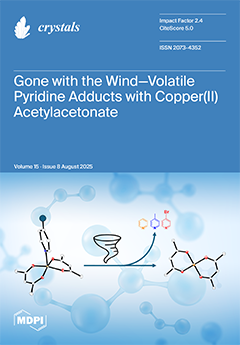N′-Phenylbenzohydrazides are valuable precursors for air- and moisture-stable Blatter radicals, with applications in magnetism and spintronics. This study presents the single-crystal X-ray structures of
N′-(4-methyl-2-nitrophenyl)benzohydrazide (
I) and
N′-(2-nitro-(4-trifluoromethyl)phenyl)benzohydrazide (
II), highlighting the influence of substituents on supramolecular
[...] Read more.
N′-Phenylbenzohydrazides are valuable precursors for air- and moisture-stable Blatter radicals, with applications in magnetism and spintronics. This study presents the single-crystal X-ray structures of
N′-(4-methyl-2-nitrophenyl)benzohydrazide (
I) and
N′-(2-nitro-(4-trifluoromethyl)phenyl)benzohydrazide (
II), highlighting the influence of substituents on supramolecular arrangement. Compounds
I and
II are found to crystallize within the monoclinic crystal system, with the space groups
I2/a and
P21/n, respectively, with centrosymmetric, one-dimensional columnar packing driven by π-π stacking. In
I, π-π dimers form between benzoyl rings (3.018 Å), with additional stacking between aryls (3.408 Å) of neighboring dimers. In
II, alternating benzoyl and aryl rings stack with interplanar distances of 2.681 and 2.713 Å. Bifurcated intra- and intermolecular hydrogen bonds (1.938–2.478 Å) further stabilize the packing. Compound
II exhibits inter-stack F···F contacts (2.924 Å), attributed to steric effects. The trifluoromethyl group enhances N′NCO-NO
2 conjugation, resulting in a near-parallel arrangement of aromatic rings and planar geometry at the N′ nitrogen. In contrast, compound
I shows reduced conjugation, leading to pyramidalization at the N′ nitrogen and increased hydrazide bond flexibility, as seen in the 56° angle between aromatic rings.
Full article





